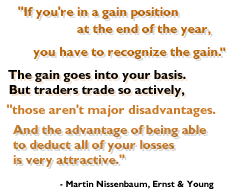|
Tax time for active traders
|
 |
April 13, 2000: 11:27 a.m. ET
April 17 is not only time to pay the piper but time to plan ahead for day traders
By Staff Writer Alex Frew McMillan
|
NEW YORK (CNNfn) - For active traders, April 17 is important not only because it's the deadline for their 1999 filing. They may also have to make their first estimated-tax payment on their 2000 taxes, and make an important decision that could influence how they file for the whole year.
By April 17 -- tax day being delayed to Monday thanks to the weekend -- traders need to meet one of three "safe-harbor" provisions on estimated tax to avoid penalties. If they have cut down or given up on other employment to concentrate on trading, knowing the estimated-tax rules is critical because their old employers are either withholding less or no tax for them.
 Martin Nissenbaum, national director of personal income tax planning for Ernst & Young, explained that traders have to make quarterly payments based either on: Martin Nissenbaum, national director of personal income tax planning for Ernst & Young, explained that traders have to make quarterly payments based either on:
- 90 percent of the current year's tax liability (i.e., 2000, for traders who believe they can forecast it correctly);
- 100 percent of the previous year's tax liability (i.e., 1999); or
- by annualizing payments through 2000 as traders incur income.
To annualize for the April 17 deadline, traders would work out their profit through March, multiply by four (to adjust for the rest of the year), calculate the tax on the total, then pay 22.5 percent of that -- 90 percent of a quarter's worth (or 25 percent) of actual taxes.
Further estimated tax payments are due as follows: June 15, for the period through May; Sept. 15, for the period through August; and Jan. 15, 2001, for the full calendar year of 2000.
If a trader doesn't meet one of the three safe harbors in each quarter, he or she pays an interest penalty retroactively, even if the shortfall is made up later in the year. Some traders may simply choose to overpay to make sure they meet the limit for a quarter, then pay less in subsequent quarters. Not surprisingly, there's no penalty for overpaying.
Trader or a dealer? Time to elect
April 17 is also the deadline for a decision that could shape how active traders file their 2000 taxes.
Traders may already face a hefty bill for 1999. By the time they file this year, or file for an extension, they have to decide if they want to make the "mark-to-market" election, which could influence their 2000 taxes substantially.
It's an election that a professional trader makes to be treated as a dealer, someone trading stock for others. The trader may still only be trading for him or herself, though.
What's known as a 475 (f) election cannot be made retroactively at the end of a year. So the April 17 election deadline for 2000 applies even for traders who are filing for an extension on their 1999 return. IRS Revenue Procedure 99-17 explains the procedure for making the election.
If a trader elects to be treated as a dealer, the trader prices all securities at market value come Dec. 31. He or she then takes any unrealized gains or losses for 2000, whether or not he or she has actually sold the securities.
Sounds bad at first but has its advantages
Why would a trader want to do that? All gains or losses are then treated as ordinary income rather than long-term capital gains. So if they have a profit, the gains are taxed at regular income-tax level -- up to 39.6 percent for 1999 federal tax.
 That's like any short-term capital gain, on investment held less than 12 months. The first time a trader makes the election, any built-up gains or losses are generally spread over four years. The trader then continues to mark to market at the end of every subsequent year, taking the gains or losses for that year, until filing with the IRS to revoke the election. That's like any short-term capital gain, on investment held less than 12 months. The first time a trader makes the election, any built-up gains or losses are generally spread over four years. The trader then continues to mark to market at the end of every subsequent year, taking the gains or losses for that year, until filing with the IRS to revoke the election.
"Regular" investors, and traders who don't make the election, pay capital gains of 20 percent on long-term investments -- investments held for more than 12 months. If they're holding on to their stock, they're likely in a lower tax bracket than traders treated as dealers.
But if regular investors were unlucky enough to have losses, there is a $3,000 cap on writing off those losses against other income.
In other words, if you had $5,000 in trading profit offset by $15,000 in trading losses, you had a net loss of $10,000. But you can only write $3,000 off against other income on this year's taxes.
The other $7,000 in losses is carried forward to next year, or the year after that if you have losses again, and "in perpetuity" if you continue losing money.
But traders who "mark to market" can take all their losses at once -- there is no $3,000 cap. If they're true day traders, they're already taking short-term gains on the majority (if not all) of their investments. They don't hold investments for 12 days, let alone 12 months. So the "mark to market" election has little negative effect because they don't have long-term capital gains.
"If you're in a gain position at the end of the year, you have to recognize the gain," Nissenbaum conceded. The gain is then calculated into your basis for the stocks you continue to hold, so you don't pay tax again when you sell them.
"But because traders tend to trade so frequently, those aren't major disadvantages," Nissenbaum continued. "And the advantage of being able to deduct all of your losses is very attractive."
Bigger write-off against other income
Traders making the election can write off those losses against any dividend or interest income they received during the year, as well as against any other income -- from a part-time job, consulting fees and the like.
What's more, traders who make the 475 (f) election are not subject to the "wash-sale" rule. That states that investors cannot write off losses on securities sold and then bought back within 30 days.
Under the "wash-sale" rule, investors and traders not making the 475 (f) election can sell a losing investment, buy a similar investment and still write off losses on the original sale. They could switch a General Motors bond for a Ford bond, for instance. But they could not buy back the same GM bond and take the loss. An investor making the "mark to market" election can.
 Another point for new traders to bear in mind is that 2000 may be the first year they can classify themselves as self-employed, professional traders. The IRS doesn't have hard-and-fast rules on who qualifies, but it's safe to say you qualify if you trade full-time. Another point for new traders to bear in mind is that 2000 may be the first year they can classify themselves as self-employed, professional traders. The IRS doesn't have hard-and-fast rules on who qualifies, but it's safe to say you qualify if you trade full-time.
The test, Nissenbaum said, is whether you seek short-term profit in your trading and you trade frequently. If you're making 100 trades a month and relying on trading for your income, you likely qualify. If you have a full-time job, you almost certainly cannot.
Check with an accountant if you are unsure. There is no form to fill out -- you just report your taxes that way. But it's wise to note that you're filing as a trader on your return, Nissenbaum said, by attaching an explanatory note.
The advantage is that professional traders can deduct trading expenses "above the line" on their Schedule C tax form. That means they're deducted out of adjusted gross income. Trading expenses can include costs such as research, computers, trade periodicals, some home-office expenses and even investment interest, if you're trading on margin.
If you qualify as a full-time trader, "it's very important," said Mike Dessoye, a day trader who started trading from his Bridgewater, N.J., home last fall and a former Bell Labs and AT&T consultant. The deductions add up. "The laws support this as a viable career."
But some of his former colleagues are trading very actively while hanging onto their full-time jobs. He thinks they are better off investing long-term, since they can't take the trading deductions but end up paying regular income tax on short-term sales.
"That's where the tax implications can kill them," Dessoye said. They pay higher taxes and get none of the write-offs. "For any of those people, unless you're extremely profitable it's not worth it. They'd be better off doing a little bit longer-term positioning."
-- Click here to send e-mail to Alex Frew McMillan
* Disclaimer 
|
|
|
|
|
 |

|

